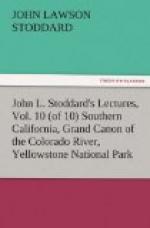The art of bridge-building in some form or other is one of the earliest necessities of civilization. Even the apes in equatorial regions will link themselves together, and swing their living line across a stream to trees on the opposite bank, thus forming a connected path of bodies along which other monkeys pass in safety. Bridges of ropes or reeds are, also, made by the most primitive of men; while viaducts of stone rose gradually in perfection, from the rude blocks heaped up by savages to the magnificent structures fashioned by the Romans. But with the introduction of iron and steel into their composition, bridges are now constructed quickly, with consummate skill, and in a multitude of different forms assist in making possible the safe and rapid transit of our great Republic.
[Illustration: HOMES OF CLIFF DWELLERS.]
[Illustration: SKULLS OF CLIFF DWELLERS.]
In addition to all the wonderful natural features of Arizona and New Mexico, the insight into ancient and modern Indian life which they afford is of extraordinary interest, particularly as aboriginal civilization, evidently, reached a higher level here than was attained by any of the tribes which roamed throughout the regions now known as the Middle and Eastern States. The natives of the arid regions of the great Southwest, though subdivided into numerous tribes, are usually known under the general title of Pueblos. The name itself, bestowed upon them by the Spaniards, is significant; since pueblo is the Spanish word for village, and this would seem to prove that the race thus designated three hundred and fifty years ago was not nomadic, but had been settled here for many years.
[Illustration: LAGUNA.]
[Illustration: CLIFF PALACES.]
Antiquity and mystery impart a charm to these Pueblo Indians. They are foundlings of history. We see their immemorial settlements, and know that, centuries before Columbus landed on San Salvador, a number of advantageously situated places in the western portion of this continent served as the homes of powerful tribes, whose towns and villages formed the scenes of warfare and barbaric splendor. But of the men who built those villages we know comparatively nothing. Their origin is almost as trackless as the sand which hides so many of their relics in a tawny sepulchre. We may be certain, however, that the remnants who survive are the representatives of myriads who once made most of the American valleys palpitant with life, but over whom oblivion has swept like a huge tidal wave, leaving the scattered fragments of their history like peaks rising from a submerged world.
[Illustration: A TWO-STORY CLIFF PALACE.]




